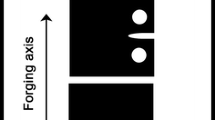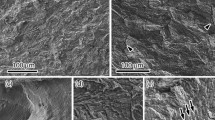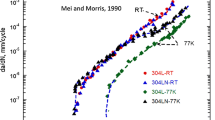Abstract
The objective of this study was to evaluate the effects of hydrogen on the fracture toughness and fracture mechanisms for the nitrogen-strengthened, austenitic stainless steel 22Cr-13Ni-5Mn, an alloy with potential value in high-pressure hydrogen containment components. The fracture initiation toughness and crack-growth resistance were measured before and after thermal precharging with hydrogen and as a function of crack-growth orientation and material strength. The effects of crack-growth orientation and material strength dominated over the effect of hydrogen exposure. The former two variables caused changes in fracture initiation toughness of up to 400 pct, while dissolved hydrogen resulted in only modest decreases in fracture initiation toughness of 20 to 40 pct. Coarse Z-phase (CrNbN) particles aligned in bands governed the measured fracture toughness and observed fracture mode. Fracture progressed by void nucleation and growth in the Z-phase bands, forming microcracks that ultimately linked through the remaining austenite matrix. Crack-growth orientation, material strength, and hydrogen exposure affected the nucleation and growth of voids in the Z-phase bands and the subsequent linking of microcracks. Control or elimination of the coarse, banded Z phase would likely enhance the fracture resistance of this alloy.










Similar content being viewed by others
References
C. San Marchi, B.P. Somerday, X. Tang, and G.H. Schiroky: Int. J. Hydrogen Energy 2007, vol. 33, pp. 889–904.
C. San Marchi, K.A. Nibur, D.K. Balch, B.P. Somerday, X. Tang, G.H. Schiroky, and T. Michler: Effects of Hydrogen on Materials, B. Somerday, P. Sofronis, and R. Jones, eds., ASM INTERNATIONAL, Materials Park, OH, 2009, pp. 88–96.
C. San Marchi, B.P. Somerday, X. Tang, and G.H. Schiroky: Proc. PVP-2008: ASME Pressure Vessels and Piping Division Conf., Chicago, IL, 2008, ASME, PVP2008-642402, New York, NY, 2008.
M.C. Mataya, C.A. Perkins, S.W. Thompson, and D.K. Matlock: Metall. Mater. Trans. A, 1996. vol. 27A, pp. 1251–66.
G.R. Caskey: in Environmental Degradation of Engineering Materials in Hydrogen, M.R. Louthan, R.P. McNitt, and R.D. Sisson, eds., Laboratory for the Study of Environmental Degradation of Engineering Materials, Virginia Polytechnic Institute, Blacksburg VA, 1981, pp. 283–302.
G.R. Caskey: Hydrogen Compatibility Handbook for Stainless Steels (DP-1643), EI du Pont Nemours, Savannah River Laboratory, Aiken, SC, 1983.
S. Fukuyama, M. Imade, T. Iijima, and K. Yokogawa: Proc. PVP-2008: ASME Pressure Vessels and Piping Division Conf., Chicago, IL 2008, ASME, PVP2008-61849, New York, NY, 2008.
L. Zhang, M. Wen, M. Imade, S. Fukuyama, and K. Yokogawa: Acta Mater., 2008, vol. 56, pp. 3414–21.
B.C. Odegard, J.A. Brooks, and A.J. West: in Effect of Hydrogen on Materials, A.W. Thompson, and I.M. Bernstein, eds., TMS-AIME, New York, NY, 1976, pp. 116–25.
B.C. Odegard and A.J. West: Mater. Sci. Eng. A, 1975, vol. 19, pp. 261–70.
C. San Marchi, D.K. Balch, K.A. Nibur, and B.P. Somerday: J. Pressure Vessel Technol., 2008, vol. 130, pp. 041401-1–041401-9.
L. Ma, G. Liang, J. Tan, L. Rong, and Y. Li: J. Mater. Sci. Technol., 1999, vol. 15, pp. 67–70.
T.L. Capeletti and M.R. Louthan: J. Eng. Mater. Technol., 1977, vol. 99, pp. 153–58.
S.L. Robinson and B.P. Somerday: in Hydrogen Effects on Material Behavior and Corrosion Deformation Interactions, N.R. Moody, A.W. Thompson, R.E. Ricker, G.W. Was, and R.H. Jones, eds., TMS, Warrendale, PA, 2003 pp. 1019–28.
M.W. Perra: in Environmental Degradation of Engineering Materials in Hydrogen, M.R. Louthan, R.P. McNitt, and R.D. Sisson, eds., VPI Press, Blacksburg, VA, 1981, pp. 321–33.
C. San Marchi, B.P. Somerday, and S.L. Robinson: Int. J. Hydrogen Energy, 2007, vol. 32, pp. 100–16.
“Standard Terminology Relating to Fatigue and Fracture Testing,” ASTM Standard E1823-09b, ASTM INTERNATIONAL, West Conshohocken, PA, 2009, DOI: 10.1520/E1823-09B, www.astm.org.
“Standard Test Method for Measurement of Fracture Toughness,” ASTM Standard E1820-05, ASTM International, West Conshohocken, PA, 2005, DOI: 10.1520/E1820-05, www.astm.org.
“Test Method for J-Integral Characterization of Fracture Toughness,” ASTM Standard E1737-96, Annual Book of ASTM Standards, 03.01, ASTM, West Conshohocken, PA, 1997, pp. 968–91.
K.A. Nibur, B.P. Somerday, D.K. Balch, and C. San Marchi: Acta Mater., 2009, vol. 57, pp. 3795–3809.
D.H. Jack and K.H. Jack: J. Iron Steel Inst., 1972 pp. 790–92.
W.M. Garrison Jr. and N.R. Moody: J. Phys. Chem. Solids, 1987, vol. 48, pp. 1035–74.
R.H. Van Stone, T.B. Cox, J.R. Low, and J.A. Psioda: Int. Met. Rev., 1985, vol. 30, pp. 157–79.
A.W. Thompson: Metall. Trans. A, 1976, vol. 10A, pp. 727–31.
A.W. Thompson: in Effect of Hydrogen on Materials, A.W. Thompson, and I.M. Bernstein, eds., TMS-AIME, Warrendale, PA, 1976, pp. 467–79.
A.W. Thompson and I.M. Bernstein: Fracture, Proc. ICF4, Waterloo, ON, Canada, 1977, pp. 249–54.
H.K. Birnbaum: Scripta Metall. Mater., 1994, vol. 31, pp. 149–53.
K.A. Nibur, D.F. Bahr, and B.P. Somerday: Acta Mater., 2006, vol. 54, pp. 2677–84.
P.J. Ferreira, I.M. Robertson, and H.K. Birnbaum: Acta Mater., 1998, vol. 46, pp. 749–57.
I.M. Robertson: Eng. Fract. Mech., 1999, vol. 64, pp. 649–73.
H.K. Birnbaum and P. Sofronis: Mater. Sci. Eng. A, 1994, vol. A176, pp. 191–202.
B.P. Somerday, M . Dadfarnia, D.K. Balch, K.A. Nibur, C.H. Cadden, and P. Sofronis: Metall. Mater. Trans. A, 2009, vol. 40A, pp. 2350–62.
Acknowledgments
Electron microscopy was conducted by J. Chames. Sandia is a multiprogram laboratory operated by Sandia Corporation, a Lockheed Martin Company, for the United States Department of Energy under Contract No. DE-AC04-94AL85000.
Author information
Authors and Affiliations
Corresponding author
Additional information
U.S. GOVERNMENT WORK NOT PROTECTED BY U.S. COPYRIGHT
Manuscript submitted January 11, 2010.
Rights and permissions
About this article
Cite this article
Nibur, K., Somerday, B., San Marchi, C. et al. Effects of Strength and Microstructure on Hydrogen-Assisted Crack Propagation in 22Cr-13Ni-5Mn Stainless Steel Forgings. Metall Mater Trans A 41, 3348–3357 (2010). https://doi.org/10.1007/s11661-010-0396-y
Published:
Issue Date:
DOI: https://doi.org/10.1007/s11661-010-0396-y




